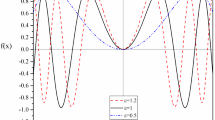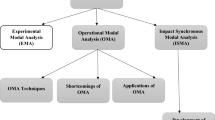Abstract
Digital twin that shows great potential in different fields may serve as the enabling technology for the health monitoring of aero-engine blade. However, due to the harsh conditions inside the aero-engine, one of the most challenging issues for the implementation of digital-twin-based blade health monitoring is the lack of an accurate connection method between the digital-twin model and the physical entity for rotating blade. Wherein, the key is how to measure the blade data accurately. The emerging blade tip timing (BTT), an effective non-contact measurement method for blades, has received extensive attention recently. Whereas, due to the limited probes that are allowed to be installed on the engine casing, the BTT signal is generally incomplete and under-sampling, which makes it very difficult to reconstruct the blade vibration parameters from the measured data. In this study, a novel paradigm for blade vibration parameter reconstruction with super-resolution from the undersampled BTT signal is proposed based on atomic norm soft thresholding (AST), which may offer accurate blade vibration information for the construction and updating of blade digital-twin model. Unlike the conventional reconstruction method that generally needs the interested signal to be sparse under a finite discrete dictionary for successful reconstruction, the proposed AST-based blade vibration parameter reconstruction method can take any continuous value in the frequency domain from the measurement data with fewer sampling numbers and higher under-sampling rate. Both numerical simulation and experimental verification are utilized to verify the validity of the proposed method. The comparative results indicate that the proposed method performs well in resisting “incomplete.” Meanwhile, the proposed method performs better than state-of-the-art methods under conditions with fewer data.
















Similar content being viewed by others
References
Abbas M, Shafiee M (2018) Structural health monitoring (SHM) and determination of surface defects in large metallic structures using ultrasonic guided waves. Sensors-Basel 18(11):3958
Bhaskar BN, Tang GG, Recht B (2013) Atomic norm denoising with applications to line spectral estimation. IEEE T Signal Proces 61(23):5987–5999
Bouchain A, Picheral J, Lahalle E, Chardon G, Vercoutter A, Talon A (2019) Blade vibration study by spectral analysis of tip-timing signals with OMP algorithm. Mech Syst Signal Pr 130:108–121
Candes EJ (2008) The restricted isometry property and its implications for compressed sensing. CR Math 346(9–10):589–592
Candes EJ, Fernandez-Granda C (2014) Towards a mathematical theory of super- resolution. Commun Pur Appl Math 67(6):906–956
Chae DH, Sadeghi P, Kennedy RA (2010) Effects of basis-mismatch in compressive sampling of continuous sinusoidal signals. 2010 2nd International Conference on Future Computer and Communication, IEEE.
Chen ZS, Sheng H, Xia YM, Wang WM, He J (2021) A comprehensive review on blade tip timing-based health monitoring: status and future. Mech Syst Signal Process 149:107330
Chi Y, Scharf LL, Pezeshki A, Calderbank AR (2011) Sensitivity to basis mismatch in compressed sensing. IEEE T Signal Process 59(5):2182–2195
Diamond S, Boyd S (2016) CVXPY: a python-embedded modeling language for convex optimization. J Mach Learn Res 17:2909–2913
Farrar CR, Worden K (2010) An introduction to structural health monitoring. Cism Courses Lect. https://doi.org/10.1007/978-3-7091-0399-9_1
Grieves M, Vickers J (2017) Digital twin: mitigating unpredictable, undesirable emergent behavior in complex systems. Transdisciplinary perspectives on complex systems. Springer, pp 85–113
Guo HT, Duan FJ, Zhang JL (2016) Blade resonance parameter identification based on tip-timing method without the once-per revolution sensor. Mech Syst Signal Process 66–67:625–639
He CB, Li H, Zhao XW (2018) Weak characteristic determination for blade crack of centrifugal compressors based on underdetermined blind source separation. Measurement 128:545–557
Joung KK, Kang SC, Paeng KS, Park NG, Choi HJ, You YJ, Von Flotow A (2006) Analysis of vibration of the turbine blades using non-intrusive stress measurement system. Proceedings of the ASME Power Conference, 391–397.
Karve PM, Guo YL, Kapusuzoglu B, Mahadevan S, Haile MA (2020) Digital twin approach for damage-tolerant mission planning under uncertainty. Eng Fract Mech 225:106766
Li YX, Chi YJ (2016) Off-the-grid line spectrum denoising and estimation with multiple measurement vectors. IEEE Trans Signal Proces 64(5):1257–1269
Li S, Yang DH, Tang GG, Wakin MB (2018) Atomic norm minimization for modal analysis from random and compressed samples. IEEE Trans Signal Proces 66(7):1817–1831
Li CF, She HX, Tang QS, Wen BC (2019) The coupling vibration characteristics of a flexible shaft-disk-blades system with mistuned features. Appl Math Model 67:557–572
Li Y, Wang X, Ding Z (2020) Multidimensional spectral super-resolution with prior knowledge with application to high mobility channel estimation. IEEE J Sel Areas Commun 38(12):2836–2852
Lin J, Hu Z, Chen ZS, Yang YM, Xu HL (2016) Sparse reconstruction of blade tip-timing signals for multi-mode blade vibration monitoring. Mech Syst Signal Pr 81:250–258
Liu ZB, Duan FJ, Niu GY, Ye DC, Feng JN, Cheng ZH, Fu X, Jiang JJ, Zhu J, Liu MR (2022) Reconstruction of blade tip-timing signals based on the MUSIC algorithm. Mech Syst Signal Process 163:108137
Mohamed ME, Bonello P, Russhard P (2019) A novel method for the determination of the change in blade tip timing probe sensing position due to steady movements. Mech Syst Signal Process 126:686–710
Mohamed ME, Bonello P, Russhard P (2020) An experimentally validated modal model simulator for the assessment of different blade tip timing algorithms. Mech Syst Signal Process 136:106484
Ritto TG, Rochinha FA (2021) Digital twin, physics-based model, and machine learning applied to damage detection in structures. Mech Syst Signal Process 155:107614
Russhard P (2010) Development of a blade tip timing based engine health monitoring system. The University of Manchester
Semper S, Romer F (2019) Admm for Nd line spectral estimation using grid-free compressive sensing from multiple measurements with applications to Doa estimation. 2019 IEEE International Conference on Acoustics, Speech and Signal Processing (ICASSP), 4130–4134.
Stephan C, Berthillier M, Lardies J, Talon A (2008) Tip-timing data analysis for mistuned bladed discs assemblies. Proc Asme Turbo Expo 2008 5:447–455
Tang GG, Bhaskar BN, Shah P, Recht B (2013) Compressed sensing off the grid. IEEE Trans Inform Theory 59(11):7465–7490
Tutuncu RH, Toh KC, Todd MJ (2003) Solving semidefinite-quadratic-linear programs using SDPT3. Math Program 95(2):189–217
Vercoutter, A., M. Berthillier, A. Talon, B. Burgardt and J. Lardies (2012) Estimation of turbomachinery blade vibrations from tip-timing data. 10th International Conference on Vibrations in Rotating Machinery, London, Sept.
Wagner M, Park Y, Gerstoft P (2021) Gridless DOA estimation and root-MUSIC for non-uniform linear arrays. IEEE Trans Signal Proces 69:2144–2157
Wang ZK, Yang ZB, Wu SM, Li HQ, Tian SH, Chen XF (2020) An improved multiple signal classification for nonuniform sampling in blade tip timing. IEEE Trans Instrum Meas 69(10):7941–7952
Wang WM, Chen K, Zhang XL, Li WB (2022) A novel method to improve the precision of BTT under rapid speed fluctuation conditions. Mech Syst Signal Process 177:109203
Wei D, Li H, Chen Y, Cao H, Fan Z, Li Y (2022) Development of blade tip timing signal simulator based on a novel model reduction method of bladed disks. J Sound Vibr. 534:117053
Witos M (2013) High sensitive methods for health monitoring of compressor blades and fatigue detection. Sci World J. 2013:1–31
Wong WK, Zhou JL (2019) CVX-based algorithms for constructing various optimal regression designs. Can J Stat 47(3):374–391
Wu XH, Zhu WP, Yan J (2018) A high-resolution doa estimation method with a family of nonconvex penalties. IEEE Trans Veh Technol 67(6):4925–4938
Wu SM, Zhao ZB, Yang ZB, Tian SH, Yang LH, Chen XF (2019) Physical constraints fused equiangular tight frame method for blade tip timing sensor arrangement. Measurement 145:841–851
Yang Z, Xie LH (2015) On gridless sparse methods for line spectral estimation from complete and incomplete data. IEEE Trans Signal Proces 63(12):3139–3153
Yang Z, Xie LH (2018) Frequency-selective Vandermonde decomposition of Toeplitz matrices with applications. Signal Process 142:157–167
Yang LH, Mao Z, Wu SM, Chen XF, Yan RQ (2021a) Steady-state coupling vibration analysis of shaft-disk-blade system with blade crack. Nonlinear Dynam 105(1):61–98
Yang LH, Yang ZS, Mao Z, Wu SM, Chen XF, Yan RQ (2021) Dynamic characteristic analysis of rotating blade with transverse crack-part I: modeling, modification, and validation. J Vib Acoust. https://doi.org/10.1115/1.4049385
Yang L, Mao Z, Wu S, Chen X, Yan R (2021c) Nonlinear dynamic behavior of rotating blade with breathing crack. Front Mech Eng 16(1):196–220
Yang LH, Mao Z, Chen XF, Yan RQ, Xie JS, Hu HF (2022) Dynamic coupling vibration of rotating shaft-disc-blade system—modeling, mechanism analysis and numerical study. Mech Mach Theor 167:104542
Acknowledgements
We thank the support given by the National Natural Science Foundation of China (52105117 & 51875433), the National Key Research and Development Program of China (2020YFB2010800), and the Funds for Distinguished Young talent of Shaanxi Province (No. 2019JC-04).
Author information
Authors and Affiliations
Contributions
Ruo Chen Jin: orignal draft, method implemention, experimental validation Laihao Yang: supervisor, funding, method Zhibo Yang (phdapple@mail.xjtu.edu.cn): co-supervisor, funding, method Yu Sun: method, discussion Ruqiang Yan: funding, discussion Xuefeng Chen: discussion.
Corresponding author
Ethics declarations
Conflict of interest
The authors declare that they have no conflict of interest.
Replication of results
Experimental data and the Python based source code for replication of the case studies will be available from the corresponding author upon request.
Additional information
Responsible Editor: Chao Hu
Publisher's Note
Springer Nature remains neutral with regard to jurisdictional claims in published maps and institutional affiliations.
Topical Collection: Advanced Optimization Enabling Digital Twin Technology.
Guest Editors: C. Hu, V. A. Gonzalez, T. Kim, O. San, Z. Hu, P. Zheng
Rights and permissions
Springer Nature or its licensor (e.g. a society or other partner) holds exclusive rights to this article under a publishing agreement with the author(s) or other rightsholder(s); author self-archiving of the accepted manuscript version of this article is solely governed by the terms of such publishing agreement and applicable law.
About this article
Cite this article
Jin, R., Yang, L., Yang, Z. et al. The connection between digital-twin model and physical space for rotating blade: an atomic norm-based BTT undersampled signal reconstruction method. Struct Multidisc Optim 66, 27 (2023). https://doi.org/10.1007/s00158-022-03436-1
Received:
Revised:
Accepted:
Published:
DOI: https://doi.org/10.1007/s00158-022-03436-1




